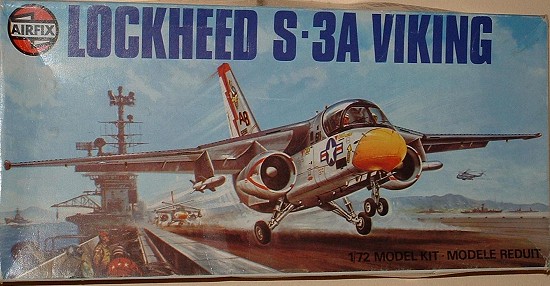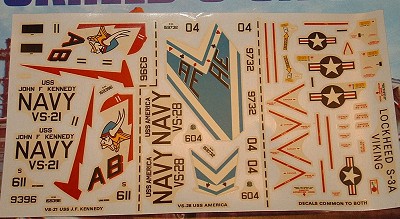
| KIT: | Airfix 1/72 S-3A Viking |
| KIT #: | 5014 |
| PRICE: | $Currently OOP, but easily found at swap meets |
| DECALS: | Two options: VS-21 & VS-28 |
| REVIEWER: | Julien Dixon |
| NOTES: | Can be found in MPC boxings as well |

| HISTORY |
When it comes to sea control and fleet reconnaissance the S-3 Viking is center stage. Originally designed as the US Navy’s carrier borne dedicated anti-submarine platform, the S-3 has since proved itself to be a flexible and valuable asset. Viking missions have ranged from armed surface reconnaissance, electronic surveillance, Surface warfare, anti-shipping. Since the retirement of the last KA-6D in 1996 the Viking is now also the air wings sole organic tanker.
If you would ask most people though it is as it’s primary role as an anti-submarine warfare (ASW) aircraft that most think of the Viking. This is after all what it was designed for.
The origins of the Viking and it’s role can be traced back to WWII when the US Navy began deploying small escort carriers in “Hunter Killer” groups to hunt and destroy German U Boat packs. After the war these groups were reformed into a separate specialized offensive ASW with the wartime Avengers being replaced by AF-2S and AF2-W Guardians. During the 1950’S these aircraft were themselves replaced by the more capable S-2 Tracker. The tracker brought significant advances in search capabilities including MAD gear and housings for sonarbouys.
However as good as these improvements were the continuing development of nuclear submarines brought about a new threat, which in turn demanded even greater improvements in ASW technology. As a result of this the Navy issued a set of specifications known as VSX, this called for the development of an airborne ASW platform which would allow the carrier its own defense. VSX called for an aircraft with exceptional range; a good loiter capability and state of the art electronics in an airframe no larger than the S-2.
VSX was issued in 1966, and was followed by a request for proposal fewer than 24 months later. There followed a yearlong competition between McDonnell Douglas, North American Rockwell, Grumman, The Convair Division of General Dynamics and Lockheed in conjunction with Vought. At the end of this two teams emerged; the first was Spearheaded by Lockheed with Vought, and the Univac Federal Systems Division of Sperry Rand. The second represented a combination of General Dynamics, Grumman and IBM
The Lockheed team had a wealth of aviation experience, which virtually guaranteed a successful end result. Having won the selection process Lockheed immediately went to work on the pre-production aircraft, with the first flight of the S-3 Avionics Flying Test Bed (a modified P-3) on 27th August 1971. Two S-3 Airframes were procured for testing with the drop test vehicle simulating 1000 landings on a carrier.
On 8th November 1971 the first prototype 157992 rolled out of the production plant in Burbank. There then followed the first flight on 21st January 1972. Within 3 months the Navy had placed an order for the first 13 production Aircraft. Other notable dates during this period were; 17th July 1972 – Testing begins; 23rd August 1972 – First successful Submerged target tracked; 26th November 1972, first aircraft to boat on the USS Forrestal (CV-59). March 1974 aircraft trials finished.
Service deliveries of the S-3 finally began in February 1974 with VS-41. By the end of 1974 VS-21, 22 and 29 were involved in the conversion process. In September 1974 VS-29 deployed for the first time with S-3’s aboard the USS Kennedy (CV-67). In the S-3 The US Navy had gained a valuable asset, which would give service for many years to come.
| THE KIT |
 I remember
building this kit as an 13 year old in 1982, (when your editor was fighting
the Cold War, Ed) and at the time it was considered
a modern kit , having been released in 1978 by Airfix. This particular kit
(which I found on an on-line auction) is dated 1978 on the Box and from what I remember
it seems to be original. I have not seen any more modern boxing by Airfix
of this kit, although I stand to be corrected. I am also unaware if this
kit was boxed for sale in North America (which it was by MPC, Ed).
I remember
building this kit as an 13 year old in 1982, (when your editor was fighting
the Cold War, Ed) and at the time it was considered
a modern kit , having been released in 1978 by Airfix. This particular kit
(which I found on an on-line auction) is dated 1978 on the Box and from what I remember
it seems to be original. I have not seen any more modern boxing by Airfix
of this kit, although I stand to be corrected. I am also unaware if this
kit was boxed for sale in North America (which it was by MPC, Ed).
You get the standard Airfix cardboard box with what I think is fairly exciting box art of an S-3 being carrier launched. I know this is what made me spend my pocket money on the kit way back in 1982!
Inside you get the Airfix bag in which even when new there seemed to be a fair amount of parts loose in the bottom, no separate bagging of different Sprues of the clear bits here.
The kit is molded in a white fairly hard but not to brittle white plastic with fine raised surface detail throughout. The kit is in a fairly standard for an aircraft consisting of two fuselage halves and each wing split into top / bottom which then butt up to the fuselage.
The cockpit is fairly basic however you do get raised detail on the instrument panels. The seats are not designed to be used on their own, but for you to put the two supplied figures in who are surprisingly well molded. The engine pods are invariably split down the middle and contain forward and rear fan bladed to assemble inside the pods. One area which is unique to this kit (as opposed to the Hasegawa Kit) is that you are able to build the kit with the main weapons bay open. There is very little detail in the bay, but once the four torpedoes are fitted in there is not much room left. In addition to the weapons bay about the only other options are to have the MAD boom out and the in-flight refueling probe out.
Now the experts will rightly tell you that these items are rarely seen out on the ground, and only then for checks. Airfix have thought of this, and in a long dead (but much in need of a revival!) tradition have provided a suitable stand in the kit. This enables the builder to make an in flight model if required with the weapons bays open and the MAD boom etc extended. I do wish you could get these stands in modern kits!
It may be seen from the box art that the S-3 is carrying under wing Harpoon missiles. No matter how good this looks, this capability was not introduced until the S-3B so it would be wrong to put it n the kit, which is a shame as you do get two fairly well molded missiles in the kit. In addition to the missiles you also get 2 well molded fuel tanks which is a much more typical load for the S-3.
As far as the
clear components go, the canopy is fairly thin and you also get the two
small windows for the rear seats. However it be clearly seen that these are
Clear and not smoked as in the real aircraft. I am unsure if Airfix were
technically able to do a smoked canopy in 1978, but even if they were I am
sure it would have made the kit more expensive. If you want one then I am
sure most modelers would be able to alter the canopy, 
Instructions These are the usual Airfix fold out ones with fairly easy to follow steps. Large colour and decal placement diagrams are on the back. Paint numbers are the old Airfix ones, although it will not take a genius to figure out the White / Grey scheme.
Decals / Paint Schemes.
The decals in the kit are for VS-21 based on the USS John F Kennedy, and VS-28 based on the USS America. At first glance these do not look useable, however they are in register and I have had good results from Airix decals this old before. However there are lots of aftermarket decals available.
Paint schemes; well, its Navy and from the 70’s / 80’s so its got to be grey and white!
| CONCLUSIONS |
This is a very good Airfix kit which, despite its age will build into a good looking model. It is not a shake an bake as the Hasegawa kit (your only other option for an S-3 in 1/72). With some modeling skills it will make a nice edition to anyones collection,
I would recommend this kit. It looks fairly simple and anyone with moderate skills should be able to make a good job of it.
Review courtesy of me, my wallet and Ebay.
If you would like your product reviewed fairly and quickly by a site that has over 250,000 visitors a month, please contact me or see other details in the Note to Contributors.